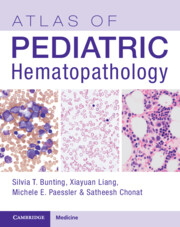Book contents
- Atlas of Pediatric Hematopathology
- Atlas of Pediatric Hematopathology
- Copyright page
- Contents
- Contributors
- Section I Peripheral Blood
- Section II Normal and Non-neoplastic Hematolymphoid Diseases
- Section III Mature Lymphoid Neoplasm
- Section IV Precursor Hematopoietic Neoplasms and Related Neoplasms
- Chapter 13 Precursor Lymphoblastic Leukemia/Lymphoma
- Chapter 14 Blastic Plasmacytoid Dendritic Cell Neoplasm
- Chapter 15 Acute Myeloid Leukemia and Related Precursor Neoplasms
- Chapter 16 Myeloproliferative Neoplasms
- Chapter 17 Myelodysplastic/Myeloproliferative Neoplasms
- Chapter 18 Childhood Myelodysplastic Syndrome
- Chapter 19 Germline Predisposition to Myeloid Neoplasia
- Chapter 20 Germline Predisposition to Lymphoid Neoplasm
- Chapter 21 Mastocytosis and Myeloid Lymphoid Neoplasms with Eosinophilia
- Section V Histiocytic Neoplasm and Miscellaneous Bone Marrow Diseases
- Index
- References
Chapter 19 - Germline Predisposition to Myeloid Neoplasia
from Section IV - Precursor Hematopoietic Neoplasms and Related Neoplasms
Published online by Cambridge University Press: 25 November 2023
- Atlas of Pediatric Hematopathology
- Atlas of Pediatric Hematopathology
- Copyright page
- Contents
- Contributors
- Section I Peripheral Blood
- Section II Normal and Non-neoplastic Hematolymphoid Diseases
- Section III Mature Lymphoid Neoplasm
- Section IV Precursor Hematopoietic Neoplasms and Related Neoplasms
- Chapter 13 Precursor Lymphoblastic Leukemia/Lymphoma
- Chapter 14 Blastic Plasmacytoid Dendritic Cell Neoplasm
- Chapter 15 Acute Myeloid Leukemia and Related Precursor Neoplasms
- Chapter 16 Myeloproliferative Neoplasms
- Chapter 17 Myelodysplastic/Myeloproliferative Neoplasms
- Chapter 18 Childhood Myelodysplastic Syndrome
- Chapter 19 Germline Predisposition to Myeloid Neoplasia
- Chapter 20 Germline Predisposition to Lymphoid Neoplasm
- Chapter 21 Mastocytosis and Myeloid Lymphoid Neoplasms with Eosinophilia
- Section V Histiocytic Neoplasm and Miscellaneous Bone Marrow Diseases
- Index
- References
Summary
There is increasing recognition of the role inherited and de novo germline mutations play in the development of myeloid neoplasia [1], particularly in children, adolescents, and young/middle-aged adults [2, 3]. Germline mutation inheritance may be autosomal dominant with variable penetrance, X-linked, or autosomal recessive. Family history of neoplasia or cytopenia may be helpful in identifying potential cases with germline predisposition. However, variability in disease penetrance within family members harboring the same mutation may mask early recognition of familial disease. Additionally, patients harboring de novo germline mutations may have no family history of disease. The World Health Organization’s (WHO) 2016 classification of tumors of the hematopoietic and lymphoid tissues recognizes three major classifications of myeloid neoplasms with germline predispositions: myeloid neoplasms without preexisting disorder or organ dysfunction, myeloid neoplasms with preexisting platelet disorders, and myeloid neoplasms with other organ dysfunctions (including inherited bone marrow failure syndromes) [1].
- Type
- Chapter
- Information
- Atlas of Pediatric Hematopathology , pp. 207 - 229Publisher: Cambridge University PressPrint publication year: 2023



